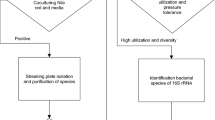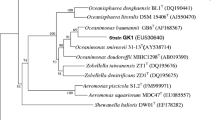Abstract
Microbial oxidation potentials of extremophiles recovered from Pampo Sul oil field, Campos Basin, Brazil, in pure culture or in consortia, were investigated using high-throughput screening (HTS) and multibioreactions. Camphor (1), cis-jasmone (2), 2-methyl-cyclohexanone (3), 1,2-epoxyoctane (4), phenylethyl acetate (5), phenylethyl propionate (6), and phenylethyl octanoate (7) were used to perform multibioreaction assays. Eighty-two bacterial isolates were recovered from oil and formation water samples and those presenting outstanding activities in HTS assays were identified by sequencing their 16S rRNA genes. These results revealed that most microorganisms belonged to the genus Bacillus and presented alcohol dehydrogenase, monooxygenase, epoxide hydrolase, esterase, and lipase activities.


Similar content being viewed by others
References
Antranikian G, Vorgias CE, Bertoldo C (2005) Extreme environments as a resource for microrganisms and novel biocatalysts. Adv Biochem Eng Biotechnol 96:219–262
Atlas RM (1981) Microbial degradation of petroleum hydrocarbons: an environmental perspective. Microbiol Rev 45:180–209
Bicalho B, Chen LS, Grognux J, Reymond JL, Marsaioli AJ (2004) Studies on whole cell fluorescence-based screening for epoxide hydrolases and Baeyer-Villiger monoxygenases. J Braz Chem Soc 15:911–916
Brito EMS, Guyoneaud R, Goñi-Urriza M, Ranchou-Peyruse A, Verbaere A, Crapez MAC, Wasserman JCA, Duran R (2006) Characterization of hydrocarbonoclastic bacterial communities from mangrove sediments in Guanabara Bay. Brazil Res Microbiol 157:752–762
Carballeira JD, Alvarez E, Sinisterra JV (2004) Biotransformation of cyclohexanone using immobilized Geotrichum candidum NCYC49: factors affecting the selectivity of the process. J Mol Catal B-Enzym 28:25–32
da Cruz GF, Santos Neto EV, Marsaioli AJ (2008) Petroleum degradation by aerobic microbiota from the Pampo Sul Oil Field, Campos Basin. Brazil Org Geochem 39:1204–1209
Egorova K, Antranikian G (2005) Industrial relevance of thermophilic Archaea. Curr Opin Microbiol 8:649–655
Gonçalves RAC, Porto ALM, Pinheiro L, Cagnon JR, Manfio GP, Marsaioli AJ (2004) Multibioreaction methodology for Baeyer-Villiger monooxygenase monitoring. Food Technol Biotechnol 42:355–361
Guardado LR, Spadini AR, Brandão JSL, Mello MR (2000) Petroleum system of the Campos Basin, Brazil. In: Mello, M.R., Katz, B.J., (Eds.), Petroleum systems of South Atlantic Margins, American Asssociation of Petroleum Geologists, Memoir 73, Chapter 22: l, pp 317–324
How CT, Patel R, Laskin AI, Barnabe N (1979) Microbial oxidation of gaseous hydrocarbons: epoxidation of C2 and C4 n-alkenes by methylotrophic bacteria. Appl Environ Microbiol 38:127–134
Jahnert R, França A, Trindade LAF, Quintaes C, Santos P, Pessoa J, Bedregal RP (1998) The petroleum system of Campos Basin. BGP; AAPG International Conference and Exhibition, November 8-11, Rio de Janeiro, Brasil. Extended abstracts volume, 600-601.
Kamembeek NM, Janssen DB, van Berkel WJH, Fraaije MW (2003) Baeyer-Villiger monooxygenases, an emerging family of flavin-dependent biocatalysts. Adv Synth Catal 345:667–678
Kimura M (1980) A simple method for estimating evolutionary rate of base substitutions through comparative studies of nucleotide sequences. J Mol Evol 16:111–120
Kumar S, Tamura K, Jakobsen IB, Nei M (2001) MEGA2: molecular evolutionary genetics analysis software, Arizona State University, Tempe, Arizona, USA. Bioinformatics 17:1244–1245
Magot M, Ollivier B, Patel BKC (2000) Microbiology of petroleum reservoirs. Antonie Van Leeuwenhoek 77:103–116
Mello MR, Gaglianone PC, Brassell SC, Maxwell JR (1988) Geochemical and biological marker assessment of depositional environments using Brazilian offshore oils. Mar Petrol Geol 5:205–223
Mohriak WU, Mello MR, Karner GD, Dewey JF, Maxwell JR (1989) Structural and stratigraphic evolution of the Campos Basin, Offshore Brazil. In: Extentional Tectonics and Stratigraphy of North Atlantic Margins, American Asssociation of Petroleum Geologists, Memoir 46, chapter 38, pp 577–598
Nieto JJ, Vargas C, Ventosa A (2000) Osmo protection mechanism in the moderately halophilic bacteria Halomonas alongata. Rec Res Dev Microbiol 4:43–54
Okoh AI (2006) Biodegradation alternative in the cleanup of petroleum hydrocarbon pollutants. Biotechnol Mol Biol Rev 1:38–50
Orihara Y, Noguchi T, Furuya T (1994) Biotransformation of (+) camphor by cultured cells of Eucalyptus perriniana. Phytochemistry 35:941–945
Patt TE, Cole GC, Hanson RS (1976) Methylobacterium a new genus of facultatively methylotrophic bacteria. Int J Syst Bacteriol 26:226–229
Pennisi E (1997) In industry, extremophiles begin to make their mark. Science 276:705–706
Pitcher DG, Saunders NA, Owen RJ (1989) Rapid extraction of bacterial genomic DNA with guanidium thiocyanate. Lett Appl Microbiol 8:151–156
Quillaguamán J, Delgado O, Mattiasson B, Hatti-Kaul R (2006) Poly (beta-hydroxybutyrate) production by a moderate halophile, Halomonas boliviensis LC1. Enz Microb Technol 38:148–154
Rangel HD, Martins FAL, Esteves FR, Feijó FJ (1994) Bacia de campos. Bol geocieÃnc Petrobrás 8:203–217
Rodrigues DC, Pantaroto S, Alves PB, Nascimento LR, Abreu Filho BA, Oliveira VM, Manfio GP, Santos Neto EV, Marsaioli AJ (2005) Linking the cyclohexyl-alkanoic acids in petroleum from the Sergipe-Alagoas and Campos basins to the acidothermophilic bacterium Alicyclobacillus sp. Org Geochem 36:1443–1453
Roy S, Hens D, Biswaz D, Biswaz D, Kumar R (2002) Survey of petroleum degrading bacteria in coastal waters of Sunderban Biosphere Reserve. W J Microbiol Biotechnol 18:575–581
Saitou N, Nei M (1987) The neighbor-joining method: a new method for reconstructing phylogenetic trees. Mol Biol Evol 4:406–425
Sette LD, Simioni KCM, Vasconcellos SP, Dussán LJ, Marsaioli AJ, Santos Neto EV, Oliveira VM (2007) Analysis of composition of bacterial communities in oil reservoirs from a southern offshore Brazilian basin. Antonie Van Leeuwenhoek 91:253–266
Sicard R, Chen LS, Marsaioli AJ, Reymond J-L (2005) A fluorescence-based assay for Baeyer-Villiger monooxygenase, hydrolases and lactonases. Adv Synth Catal 347:1041–1050
Tango MSA, Islam MR (2002) Potential of extremophiles for biotechnological and petroleum applications. Energy Sources 24:543–559
Thompson JD, Gibson TJ, Plewniak F, Jeanmougin F, Higgins DG (1997) The ClustalX windows interface: flexible strategies for multiple sequence alignment aided by quality analysis tools. Nucl Acid Res 24:4876–4882
Van Hamme JD, Singh A, Ward OP (2003) Recent advances in petroleum microbiology. Microbiol Mol Biol Rev 67:503–549
Wahler D, Reymond J-L (2001) High-throughput screening for biocatalysts. Curr Opin Biotechnol 12:535–544
Walker JD, Cowell RR (1976) Enumeration of petroleum-degrading microorganisms. Appl Environ Microbiol 31:198–207
Yoshida N, Yagi K, Sato D, Watanabe N, Kuroishi T, Nishimoto K, Yanagida A, Katsuragi T, Kanagawa T, Kurane R, Tani Y (2005) Bacterial communities in petroleum oil in stockpiles. J Biosci Bioeng 99:143–149
Zinder SH, Cardwell SC, Anguish T, Lee M, Koch M (1984) Methanogenesis in a thermophilic anaerobic digestour: Methanotrix sp. as an important aceticlastic methanogen. Appl Environ Microbiol 47:796–807
Acknowledgments
This work was part of the multidisciplinary project BIOPETRO supported by FINEP and PETROBRAS. GF da Cruz and SP Vasconcellos were supported by grants from Coordenação de Aperfeiçoamento de Pessoal de Nível Superior (CAPES). CFF Angolini, PF Lopes, and E. Crespim were supported by Conselho Nacional de Desenvolvimento Científico e Tecnológico (CNPq, Brazil), while LG Oliveira received a fellowship from Fundação de Amparo à Pesquisa do Estado de São Paulo (FAPESP). We thank PETROBRAS for the authorization to publish this work. We also thank Prof. Carol Collins for helpful suggestions in style and grammar.
Author information
Authors and Affiliations
Corresponding author
Rights and permissions
About this article
Cite this article
da Cruz, G.F., Angolini, C.F.F., de Oliveira, L.G. et al. Searching for monooxygenases and hydrolases in bacteria from an extreme environment. Appl Microbiol Biotechnol 87, 319–329 (2010). https://doi.org/10.1007/s00253-010-2485-7
Received:
Revised:
Accepted:
Published:
Issue Date:
DOI: https://doi.org/10.1007/s00253-010-2485-7




